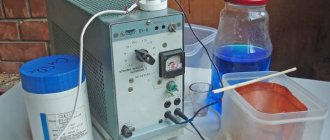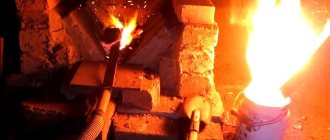The issues of effective protection and decorative design of the surfaces of products made of various materials are quite relevant both for manufacturers and for many home craftsmen. Chemical metallization, which you can do yourself, allows you to effectively solve such problems.
Chemical metallization technology can be used on virtually any hard surface
Types of metallization
Metallization of products, as the name of this process implies, involves applying a thin metal layer to their surface. Not only metal, but also plastic, wood, glass and other materials can be subjected to such processing. The most popular and well-known types of this process are metallization with chromium (chrome plating), coating the surface of the product with a layer of zinc (zinc plating), less known is aluminizing, during which a layer of aluminum is applied to the surface.
Chemical metallization. Mirror frame
Depending on what equipment and what technology is used for metallization, this processing is divided into various types. Thus, today the following methods of applying metal coating are well developed and actively used:
- galvanic metallization, performed in baths with a special electrolyte;
- electric arc metallization, in which the coating is applied to the surface to be treated by electric arc melting of a metal electrode and subsequent spraying of the molten metal using a jet of compressed air;
- gas plasma spraying, in which, as with arc technology, the metal is applied to the surface of the product in a molten, finely dispersed state (like electric arc metallization, gas plasma spraying is a rather complex technological process, so they are used mainly in production conditions);
- cladding – application of a layer of metal to the surface and its subsequent hot rolling;
- diffusion metallization, the essence of which is that atoms of the applied metal, under the influence of high temperature, penetrate into the surface layer of the workpiece;
- hot metallization - the formation of a coating by immersing the product in a bath of molten metal;
- chemical metallization.
It is worth dwelling on the latest technology in more detail, since it is optimally suited for applying metal coatings to various products with your own hands at home.
Technological features of chemical metallization
Chemical metallization can be carried out for various purposes, the main of which is to improve the decorative characteristics of the processed product. In addition, the coating obtained by chemical metallization makes it possible to hide such defects of the treated surface as small pores and microcracks. In some cases, this technology is used to restore the surface.
If we summarize the goals of using this processing method, they all consist of improving the characteristics of the material from which the product is made. Such characteristics include, in particular:
- decorative properties;
- corrosion resistance;
- hardness;
- wear resistance, etc.
At the same time, by applying a metal layer to the surface using a chemical method, it is possible to obtain a coating with the required characteristics.
The chemical metallization process is divided into several stages, which can be easily carried out in any paint and varnish production.
The main task that needs to be solved when performing chemical metallization is to provide optimal conditions for the occurrence of redox reactions. When such conditions are provided, atoms are released from the composition of the chemical substance, the redox potential of which is at a higher level. Of course, such a process is difficult to control visually, but its result - a change in the color of the treated surface - will be noticeable immediately.
The technology itself for performing metallization using a chemical method is as follows: special chemical reagents are applied to the product, which begin to react with each other. As a result, a thin layer of metal is formed on the treated surface. A metal coating obtained by a chemical method can be made not only in a specific color, but also have several shades with smooth transitions between them. The method of catalytic chrome plating of products, known to many specialists and home craftsmen, by the way, is also performed using chemical metallization technology.
If you watch the implementation of chemical metallization on video, you will notice that this method is not complicated. From the outside, this method of applying metal coating resembles simple surface painting.
The essence of technology
Chemical metallization technology can be used to achieve a variety of purposes, most of which are associated with changing the decorative qualities of the surface. In addition, this processing method allows you to hide the main defects of metal or other material: microscopic cracks and pores, other structural defects. In some cases, technology is used to restore coverage.
The essence of the technology is to apply a thin layer of metal. The specifics of the substance application process depend on the specific technology, of which there are quite a few.
Metallization allows you to impart certain performance qualities to parts. Among the achieved characteristics of the processed product, we note the following:
- Hardness increases. Metal is more durable than plastic. By covering the surface of plastic or wooden products with it, you can protect the base from mechanical stress.
- Decorative properties increase. The metallic glossy finish looks very attractive.
- The wear-resistant qualities of the surface are improved. Metallization is often carried out in order to reduce friction between contacting parts.
Parts after chemical metallization
Parts that have high hardness and wear resistance are used in a wide variety of fields. However, high performance can only be ensured if all recommendations are followed.
Classic metallization technology has the following features:
- Several reagents are applied, which react to form a surface layer with certain performance properties. There are many different methods for transferring reagents to workpieces, each with its own characteristics, advantages and disadvantages.
- As a result of metallization, a protective layer is formed on the substrate. In this case, a reliable connection is formed between the coating and the substrate, which is maintained over a long period.
- The resulting coating can be of a wide variety of shades. If necessary, you can create a transition from one color to another without a clear boundary. In some cases, when it is necessary to obtain a surface with special decorative qualities, a dye is added during metallization.
Chemical metallization of different colors
The chemical treatment in question can be carried out in a home workshop, despite the fact that metallization is considered a complex technological process. As a rule, at home the workpiece is subjected to catalytic chrome plating. Due to this, the coating becomes attractive and gains protection from moisture.
Chemical metallization of metal is also in demand because it can be used at home. The work is carried out according to the following algorithm of actions:
- The part is cleaned of contaminants. There should be no layer between the surface layer and the base, as this will significantly reduce the performance characteristics.
- Degreasing is carried out. It is carried out using a special alkaline solution or a special detergent that can remove organic contamination from the surface.
- The degreased surface is additionally washed with clean water. In a similar way, previously used compounds can be removed from the surface during degreasing.
- Surface areas that should not be exposed to the chemical are treated with lead. The tests carried out indicate that lead does not react to the influence of an electrolytic solution.
- Wiring is connected to the solution bath to supply electricity, after which the part is lowered into the prepared reagents.
- After the required period has passed, the product is removed from the solution, dried, and then cooled. If the coating is of high quality, then it is polished.
To carry out the process under consideration at home, you can purchase a special mini-installation designed for chemical metallization, which runs on a small compressor.
The process in question should only be carried out in compliance with the following recommendations:
- Before immersing the part in the bath and applying electricity, you need to check that all contacts are connected securely and can withstand the load.
- The room in which the work in question will be carried out must be ventilated. For this purpose, a ventilation system is installed. This recommendation is due to the fact that during the metal plating process gases are released that can negatively affect vision and breathing.
Parts subjected to chemical metallization
To comply with metallization technology, you must have sufficient experience. You should not expect that when carrying out a complex operation of transferring one material to another for the first time, you will get a result that can be achieved using special industrial equipment.
Materials and equipment used
Chemical metallization, as mentioned above, can be done with your own hands and in a home workshop. Moreover, products that are small in size and simple in shape are processed using this method even without the use of special equipment. If you have such equipment at your disposal, then you can chemically apply a layer of metal even to large parts of complex configurations.
When performing this procedure yourself, you should be extremely careful, as this involves using chemicals that are hazardous to health. If you properly prepare the equipment and materials for performing chemical metallization, then you can obtain coatings on various products with your own hands at home, the quality of which is practically no different from those formed at the factory.
Reagents for chemical metallization
The kit for chemical metallization must contain reagents that have the properties of an activator and a reducer. To perform this procedure, you will also need a primer, which is applied to the surface to be treated, and a varnish that protects the finished coating from the negative influence of external factors. To apply the final varnish coating, you should choose a material that has high hardness and wear resistance.
To color the applied metal layer in the desired color, you can use a special color toner. The primer mentioned above is necessary in order to improve the adhesion of the applied metal layer to the material from which the product being processed is made. The result of do-it-yourself chemical metallization may not always be of high quality. However, the applied coating can be removed using special removing solutions.
The chemical metallization unit is designed for coating any hard surface
Decorative chrome plating technology: chemical metallization for beginners
Before doing decorative chrome plating, the question is where to get the chemicals and how to prepare it all.
And so, we are looking for chemistry in the so-called medical warehouses - these are organizations that sell medical equipment and chemicals. You can look for similar organizations in your city. If there are none, you can only rely on the Internet. There are offices that can send chemicals to an individual, but mostly organizations selling chemicals work as legal entities. So, whoever is looking will find it, I won’t give specific links (I buy from locals myself). The dishes can be found in regular hardware stores.
The picture shows the minimum set you need for your first experience in chemical metallization of mirror silver using the spraying method.
From chemistry you will need:
- Silver nitrate – 20 g.
- Stannous chloride – 25 g.
- Glucose – 25 gr.
- Sodium hydroxide – 100 g.
- Ammonia – 50 ml.
- Hydrochloric acid – 200 ml. (Can be replaced with acetic acid 70%)
- Formalin - 10 ml.
- Sodium Thiosulfate - 5 g. (reaction inhibitor)
This set is enough for up to 15 m2. This can be repeated 10 times the experiment described here (dilute 0.5 liters of solutions per experiment).
Attention! If there are problems with purchasing reagents in your city (there are none at all or they are not sold to individuals). Or just to “try” there is no point in purchasing in large quantities. For example, stannous chloride, glucose and sodium hydroxide are sold by weight in kilograms, hydrochloric acid, formaldehyde and ammonia are sold in liter bottles, and they are unlikely to be sold in smaller volumes. Just like silver nitrate less than 50 grams is not sold.
I will help you purchase a set of reagents for 5 liters of solutions, this is for 15 m2 of coverage. I will send you more details by email. Send your email via the form:
Utensils you will need:
Measuring cups for chemistry 4 pieces per 1 liter. Or you can get by with one glass, but you will have to rinse it thoroughly with distilled water each time, after each previous solution.
One measuring cup for 200 ml 100 gram bottles 3 pcs. (Pour hydrochloric acid, ammonia and formalin into them from liter bottles, as it is not convenient to collect). Disposable syringes for 3, 20 and 50 cubes.
Disposable glasses 50 ml. (for weighing chemistry), knives (for mixing solutions). It is more convenient to place bulk chemicals in food-grade plastic containers 3 pcs. Hand-held household sprayers for half a liter - 3 pcs.
One one and a half liter, pneumatic, garden sprayer for distilled water. Miniature electronic scales, measuring up to 200 g, stand out. They can be purchased at radio component stores.
In conclusion, I want to say that mastering the technology of decorative chrome plating does not require extra effort or great talent. Everything has long been invented and tested by experience. To make it easier to master the technology, there are easy-to-understand and affordable video courses on Decorative Chrome Plating Technology; there are materials and equipment that are also affordable. You can find all this on the website shophrom.ru
You also have a great opportunity to get access to training videos of the closed section of the channel on YouTube, plus an unlimited number of personal consultations on decorative chrome plating at any time, except at night, of course. It is enough to become a sponsor of the HROM INFO
and always receive information support until you learn the art of chemical metallization. This activity brings deep satisfaction. Because you make very beautiful things that leave no one indifferent when looking at such beauty.
The button to become a sponsor is located under the video.
I would like to add that the number of sponsors is limited, no matter how much I would like it, but physically I cannot work with a large number of people.
So, if you decide to learn metallization faster, become a sponsor of the channel right now. I will be very grateful. All the best, see you on the channel. BECOME A SPONSOR











